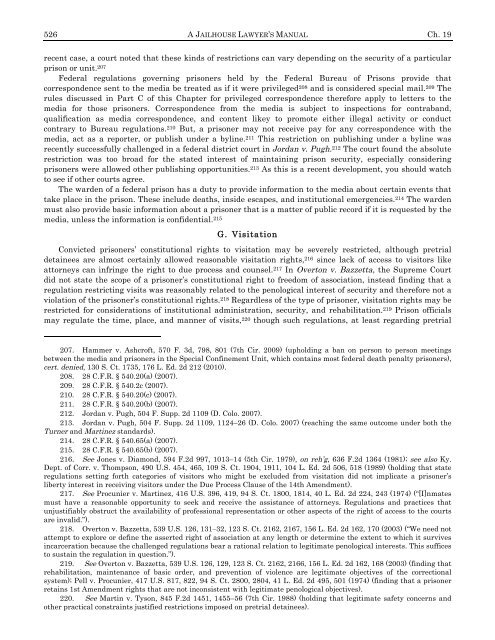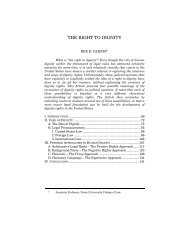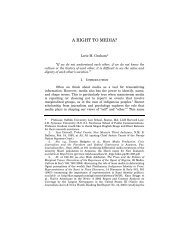Ch. 19 YOUR RIGHT TO COMMUNICATE WITH THE OUTSIDE WORLD 525As a general rule, gay and lesbian prisoners may seek <strong>to</strong> obtain non-sexually explicit homosexualmaterial through <strong>the</strong> mail. Federal regulations seem <strong>to</strong> allow <strong>the</strong> wholesale admission of <strong>the</strong>se materialsin<strong>to</strong> <strong>the</strong> federal prison environment. 196 State prisoners who desire such material, however, may encounter<strong>the</strong> same arguments used by prison officials <strong>to</strong> ban sexually explicit homosexual materials. For instance, onecourt applied an identification <strong>the</strong>ory in Harper v. Wallingford 197 <strong>to</strong> find that a prisoner’s First Amendmentrights were not violated when non-explicit mail promoting consensual sexual relationships between adultmen and juvenile males was withheld from him. The court found legitimate <strong>the</strong> prison officials’ concern that<strong>the</strong> material, when seen by o<strong>the</strong>r prisoners, would make <strong>the</strong> prisoner a target as a homosexual and wouldthus make him vulnerable <strong>to</strong> assault. However, because one of <strong>the</strong> main arguments used by prison officials<strong>to</strong> legitimize <strong>the</strong>ir security interests in <strong>the</strong>se restrictions is one of identification, such arguments might fail<strong>to</strong> persuade courts where it is clear that <strong>the</strong> prisoner is already known <strong>to</strong> be gay. 198 For more information ongay, lesbian, bisexual, and transgender issues, see JLM, Chapter 30.Courts have also upheld restrictions on explicit heterosexual materials, 199 including sexually explicitpho<strong>to</strong>graphs of prisoners’ wives or girlfriends. 200 While <strong>the</strong>se restrictions are almost always found <strong>to</strong> beconstitutional, a few courts have scrutinized such regulations much more closely. In Aiello v. Litscher, 201 <strong>the</strong>court held that a regulation banning all written or visual materials containing nudity or sexual behavior was<strong>to</strong>o vague because it would also ban important works of art and literature. It noted that a jury could findthat <strong>the</strong> prohibition of such works is not reasonably related <strong>to</strong> legitimate penological interests. It alsoconcluded that <strong>the</strong>re was no evidence that such materials threaten security or rehabilitation. 202F. Access <strong>to</strong> <strong>the</strong> News MediaYou may want <strong>to</strong> publicize your case by attracting <strong>the</strong> media’s attention. The Supreme Court has heldthat a reasonable and effective means of communication between prisoners and <strong>the</strong> media must exist. 203 But,prisons have a legitimate security interest in limiting access <strong>to</strong> outside visi<strong>to</strong>rs, including <strong>the</strong> press. 204 Thecourt held that limiting or prohibiting face-<strong>to</strong>-face interviews with <strong>the</strong> press does not violate <strong>the</strong> FirstAmendment as long as prisoners can still communicate with <strong>the</strong> press through writing or those allowed <strong>to</strong>visit. 205 In Houchins v. KQED, <strong>the</strong> Supreme Court repeated that freedom of <strong>the</strong> press does not grant <strong>the</strong>media special access <strong>to</strong> prisons. 206 As such, physical access by <strong>the</strong> news media (through visitation, <strong>to</strong>urs,pho<strong>to</strong>graphs, etc.) can be restricted just as physical access by <strong>the</strong> public based on security interests can. In a196. See Thornburgh v. Abbott, 490 U.S. 401, 404, 109 S. Ct. 1874, 1877, 104 L. Ed. 2d 459, 467 (1989) (notingthat publications must be “detrimental <strong>to</strong> <strong>the</strong> security, good order, or discipline of <strong>the</strong> institution or facilitate criminalactivity” before <strong>the</strong>ir access can be restricted).197. Harper v. Wallingford, 877 F.2d 728, 733 (9th Cir. 1989).198. See Espinoza v. Wilson, 814 F.2d 1093, 1098–99 (6th Cir. 1987) (finding that protecting <strong>the</strong> sexual identity of<strong>the</strong> prisoners was not a valid reason for restricting access <strong>to</strong> homosexual publications since <strong>the</strong> prisoners were alreadyopen about being gay but finding in favor of <strong>the</strong> warden because he stated o<strong>the</strong>r legitimate reasons for restrictingaccess).199. Mauro v. Arpaio, 188 F.3d 1054, 1059–60 (9th Cir. 1999) (upholding restrictions on explicit heterosexualmaterials as reasonably related <strong>to</strong> <strong>the</strong> goal of preventing sexual harassment of female prison guards).200. Giano v. Senkowski, 54 F.3d 1050, 1055–56 (2d Cir. 1995) (holding that <strong>the</strong> regulation was rationally related<strong>to</strong> <strong>the</strong> prevention of prisoner violence; <strong>the</strong> court pointed out that o<strong>the</strong>r avenues are available for reinforcing emotionalbonds, such as non-nude pho<strong>to</strong>graphs or romantic letters, and for satisfying <strong>the</strong> right <strong>to</strong> graphic sexual imagery, such ascommercially produced erotica or sexually graphic letters).201. Aiello v. Litscher, 104 F. Supp. 2d 1068 (W.D. Wis. 2000).202. Aiello v. Litscher, 104 F. Supp. 2d 1068, 1079–81 (W.D. Wis. 2000). See also Kaufman v. McCaughtry, 419F.3d 678, 685 (7th Cir. 2005) (following Aiello in finding that a definition of “pornography” agreed <strong>to</strong> in a settlement by<strong>the</strong> parties could not be contested as overly broad).203. Pell v. Procunier, 417 U.S. 817, 94 S. Ct. 2800, 41 L. Ed. 2d 495 (1974).204. Pell v. Procunier, 417 U.S. 817, 826, 94 S. Ct. 2800, 2806, 41 L. Ed. 2d 495, 503–04 (1974); see also Saxbe v.Washing<strong>to</strong>n Post Co., 417 U.S. 843, 850, 94 S. Ct. 2811, 2815, 41 L. Ed. 2d 514, 519–20 (1974) (Pell’s companion case,finding that under <strong>the</strong> Federal Bureau of Prisons regulations, <strong>the</strong> media does not have <strong>the</strong> right <strong>to</strong> access prisons andinmates beyond <strong>the</strong> rights granted <strong>to</strong> members of <strong>the</strong> general public. Saxbe differs from Pell in that Saxbe only looks at<strong>the</strong> rights of <strong>the</strong> media, while Pell also addresses <strong>the</strong> rights of prisoners <strong>to</strong> communicate with <strong>the</strong> media).205. Pell v. Procunier, 417 U.S. 817, 94 S. Ct. 2800, 41 L. Ed. 2d 495 (1974). For example, <strong>the</strong> California policy inPell allowed prisoners face <strong>to</strong> face visits with members of <strong>the</strong>ir family, <strong>the</strong>ir clergy, <strong>the</strong>ir at<strong>to</strong>rneys, and friends of prioracquaintance. Pell v. Procunier, 417 U.S. 817, 824–25, 94 S. Ct. 2800, 2085, 41 L. Ed. 2d 495, 503 (1974).206. Houchins v. KQED, 438 U.S. 1, 98 S. Ct. 2588, 57 L. Ed. 2d 553 (1978).
526 A JAILHOUSE LAWYER’S MANUAL Ch. 19recent case, a court noted that <strong>the</strong>se kinds of restrictions can vary depending on <strong>the</strong> security of a particularprison or unit. 207Federal regulations governing prisoners held by <strong>the</strong> Federal Bureau of Prisons provide thatcorrespondence sent <strong>to</strong> <strong>the</strong> media be treated as if it were privileged 208 and is considered special mail. 209 Therules discussed in Part C of this Chapter for privileged correspondence <strong>the</strong>refore apply <strong>to</strong> letters <strong>to</strong> <strong>the</strong>media for those prisoners. Correspondence from <strong>the</strong> media is subject <strong>to</strong> inspections for contraband,qualification as media correspondence, and content likey <strong>to</strong> promote ei<strong>the</strong>r illegal activity or conductcontrary <strong>to</strong> Bureau regulations. 210 But, a prisoner may not receive pay for any correspondence with <strong>the</strong>media, act as a reporter, or publish under a byline. 211 This restriction on publishing under a byline wasrecently successfully challenged in a federal district court in Jordan v. Pugh. 212 The court found <strong>the</strong> absoluterestriction was <strong>to</strong>o broad for <strong>the</strong> stated interest of maintaining prison security, especially consideringprisoners were allowed o<strong>the</strong>r publishing opportunities. 213 As this is a recent development, you should watch<strong>to</strong> see if o<strong>the</strong>r courts agree.The warden of a federal prison has a duty <strong>to</strong> provide information <strong>to</strong> <strong>the</strong> media about certain events thattake place in <strong>the</strong> prison. These include deaths, inside escapes, and institutional emergencies. 214 The wardenmust also provide basic information about a prisoner that is a matter of public record if it is requested by <strong>the</strong>media, unless <strong>the</strong> information is confidential. 215G. VisitationConvicted prisoners’ constitutional rights <strong>to</strong> visitation may be severely restricted, although pretrialdetainees are almost certainly allowed reasonable visitation rights, 216 since lack of access <strong>to</strong> visi<strong>to</strong>rs likeat<strong>to</strong>rneys can infringe <strong>the</strong> right <strong>to</strong> due process and counsel. 217 In Over<strong>to</strong>n v. Bazzetta, <strong>the</strong> Supreme Courtdid not state <strong>the</strong> scope of a prisoner’s constitutional right <strong>to</strong> freedom of association, instead finding that aregulation restricting visits was reasonably related <strong>to</strong> <strong>the</strong> penological interest of security and <strong>the</strong>refore not aviolation of <strong>the</strong> prisoner’s constitutional rights. 218 Regardless of <strong>the</strong> type of prisoner, visitation rights may berestricted for considerations of institutional administration, security, and rehabilitation. 219 Prison officialsmay regulate <strong>the</strong> time, place, and manner of visits, 220 though such regulations, at least regarding pretrial207. Hammer v. Ashcroft, 570 F. 3d, 798, 801 (7th Cir. 2009) (upholding a ban on person <strong>to</strong> person meetingsbetween <strong>the</strong> media and prisoners in <strong>the</strong> Special Confinement Unit, which contains most federal death penalty prisoners),cert. denied, 130 S. Ct. 1735, 176 L. Ed. 2d 212 (2010).208. 28 C.F.R. § 540.20(a) (2007).209. 28 C.F.R. § 540.2c (2007).210. 28 C.F.R. § 540.20(c) (2007).211. 28 C.F.R. § 540.20(b) (2007).212. Jordan v. Pugh, 504 F. Supp. 2d 1109 (D. Colo. 2007).213. Jordan v. Pugh, 504 F. Supp. 2d 1109, 1124–26 (D. Colo. 2007) (reaching <strong>the</strong> same outcome under both <strong>the</strong>Turner and Martinez standards).214. 28 C.F.R. § 540.65(a) (2007).215. 28 C.F.R. § 540.65(b) (2007).216. See Jones v. Diamond, 594 F.2d 997, 1013–14 (5th Cir. 1979), on reh’g, 636 F.2d 1364 (1981); see also Ky.Dept. of Corr. v. Thompson, 490 U.S. 454, 465, 109 S. Ct. 1904, 1911, 104 L. Ed. 2d 506, 518 (1989) (holding that stateregulations setting forth categories of visi<strong>to</strong>rs who might be excluded from visitation did not implicate a prisoner’sliberty interest in receiving visi<strong>to</strong>rs under <strong>the</strong> Due Process Clause of <strong>the</strong> 14th Amendment).217. See Procunier v. Martinez, 416 U.S. 396, 419, 94 S. Ct. 1800, 1814, 40 L. Ed. 2d 224, 243 (1974) (“[I]nmatesmust have a reasonable opportunity <strong>to</strong> seek and receive <strong>the</strong> assistance of at<strong>to</strong>rneys. Regulations and practices thatunjustifiably obstruct <strong>the</strong> availability of professional representation or o<strong>the</strong>r aspects of <strong>the</strong> right of access <strong>to</strong> <strong>the</strong> courtsare invalid.”).218. Over<strong>to</strong>n v. Bazzetta, 539 U.S. 126, 131–32, 123 S. Ct. 2162, 2167, 156 L. Ed. 2d 162, 170 (2003) (“We need notattempt <strong>to</strong> explore or define <strong>the</strong> asserted right of association at any length or determine <strong>the</strong> extent <strong>to</strong> which it survivesincarceration because <strong>the</strong> challenged regulations bear a rational relation <strong>to</strong> legitimate penological interests. This suffices<strong>to</strong> sustain <strong>the</strong> regulation in question.”).219. See Over<strong>to</strong>n v. Bazzetta, 539 U.S. 126, 129, 123 S. Ct. 2162, 2166, 156 L. Ed. 2d 162, 168 (2003) (finding thatrehabilitation, maintenance of basic order, and prevention of violence are legitimate objectives of <strong>the</strong> correctionalsystem); Pell v. Procunier, 417 U.S. 817, 822, 94 S. Ct. 2800, 2804, 41 L. Ed. 2d 495, 501 (1974) (finding that a prisonerretains 1st Amendment rights that are not inconsistent with legitimate penological objectives).220. See Martin v. Tyson, 845 F.2d 1451, 1455–56 (7th Cir. 1988) (holding that legitimate safety concerns ando<strong>the</strong>r practical constraints justified restrictions imposed on pretrial detainees).















